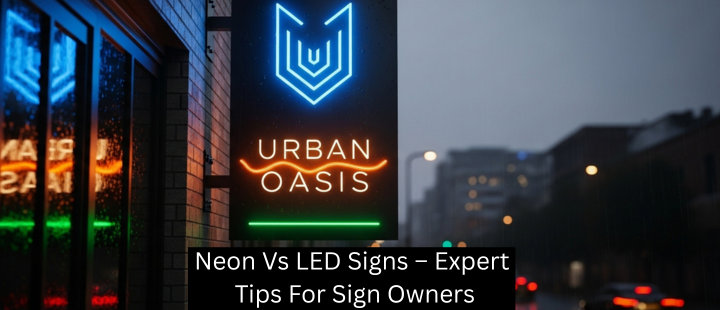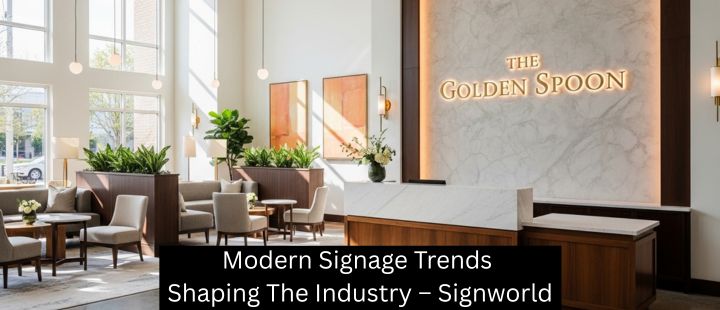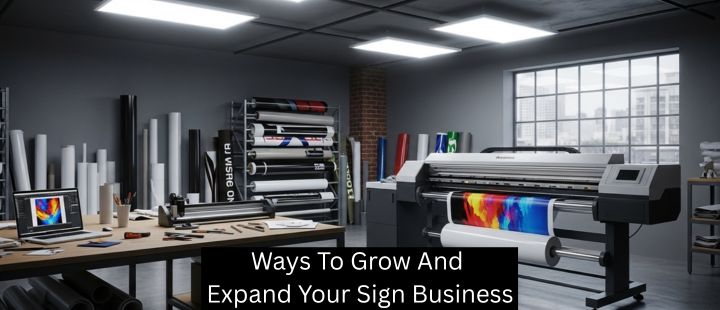Neon signs use glass tubes filled with gas to create a classic glow. LED signs use tiny light-emitting diodes arranged in modules or strips. Both can showcase your logo, tagline, and storefront messages, but they feel different. Neon signs deliver a nostalgic, retro look with a warm halo effect. LED signs offer crisp lines, vibrant colors, and modern effects like animation and dimming. If you want “heritage charm,” neon signs fit. If you want “sleek and efficient,” LED signs usually win. As a sign owner comparing neon vs LED signs, start with your brand personality, your visibility needs, and how much you want to spend over the long term.
Brightness And Visibility In The Real World
LED signs are typically brighter and easier to read in daylight, which helps storefront visibility on busy streets. They handle thin strokes and small letter sizes well, keeping copy clear from a distance. Neon signs glow beautifully at night and create mood, but very fine strokes can be harder to read from far away. For wayfinding, menu boards, open/close displays, or price messages, LED business signs usually provide stronger legibility. For lounges, galleries, bars, and lifestyle brands, the soft neon aura can be unforgettable. Think about foot traffic patterns, ambient light, and viewing distance before you choose.
Energy Use And Total Cost Of Ownership
Power consumption is where LED signs shine. They use less electricity than traditional neon, which can reduce operating costs month after month. That matters for locations with long daily run times or multiple sign faces. While custom neon can be cost-effective for simple shapes, complex neon layouts often require more glass work and higher power. Over a three-to-five-year period, many owners find LEDs cheaper to run. If your priority is energy-efficient signage and predictable utility bills, LED is a safe bet. If the brand value of authentic neon outweighs utility savings, budget accordingly and plan your hours of operation.
Lifespan, Service, And Uptime
Both technologies can last for years when professionally produced and serviced. LEDs typically deliver longer lifespans and steadier uptime, especially in outdoor environments with vibration or temperature swings. Neon uses glass and high-voltage transformers; impacts or extreme weather can increase service needs. For franchises or multi-site retailers who need consistent performance, LED storefront signs often lower downtime risk. For boutique brands that trade on atmosphere, a neon feature wall or window script can be maintained on a regular schedule. Either way, partner with a professional shop for installation and periodic inspections to keep your sign dependable.
Design, Brand Vibe, And Compliance
Neon’s hand-bent glass gives organic curves and a timeless feel—perfect for hospitality, fashion, and arts spaces. LED’s modular tech handles custom channel letters, ultra-thin strokes, RGB effects, dimming, and animated sequences. If your guidelines mandate exact Pantone consistency across locations, LEDs usually provide tighter color control. For historic districts, neon might align with local design codes; in others, LEDs may be preferred for efficiency. Always verify size, luminance, and placement rules before fabrication. A strong sign partner like Signworld can translate brand standards, landlord criteria, and municipal codes into compliant, high-impact designs.
Safety And Sustainability Considerations
Modern LED systems run at lower voltage and produce less heat, which can enhance safety and reduce enclosure requirements. Neon uses high voltage and contains gases; it must be built and serviced by trained professionals. On sustainability, LEDs’ reduced power draw supports energy goals, and many components are recyclable through specialized streams. Neon glass can also be recycled by qualified facilities, and the classic build can be repaired for decades, extending product life. If your ESG goals emphasize reduced energy, LEDs lead. If longevity through repairability matters, well-made neon can be a durable, storied asset.
When To Choose Which (And How Signworld Helps)
Choose LED signs if you need maximum brightness, low energy costs, precise brand colors, and minimal upkeep across multiple locations. Choose neon signs if you want a distinctive, emotional glow that fits a vintage or artistic identity and you’re comfortable with scheduled service. Many brands succeed with a hybrid approach: LED for primary identification and wayfinding; neon for feature walls or accent messages.
At Signworld, we help sign owners compare options, model long-term costs, align with brand guidelines, and meet local codes. Our experts review visibility, energy use, and life-cycle plans so your neon or LED sign delivers real business results—not just good looks. Ready to make the right choice for your storefront or interior? Talk to Signworld for a clear, brand-first recommendation tailored to your space and goals.




